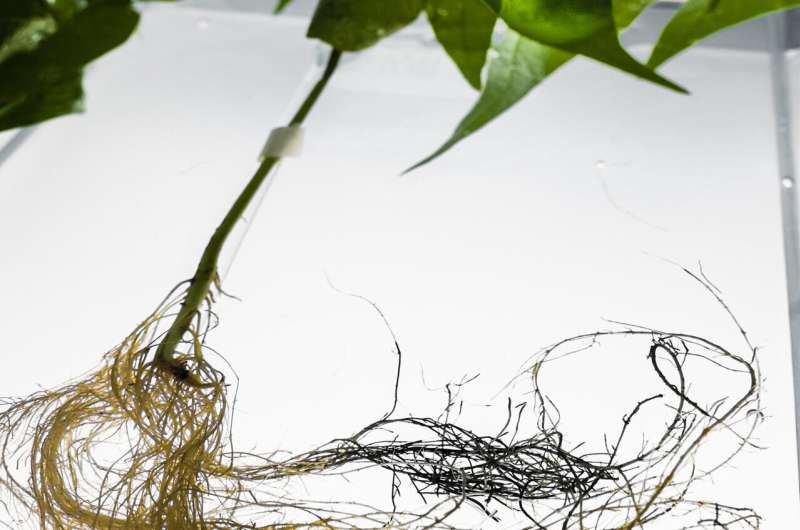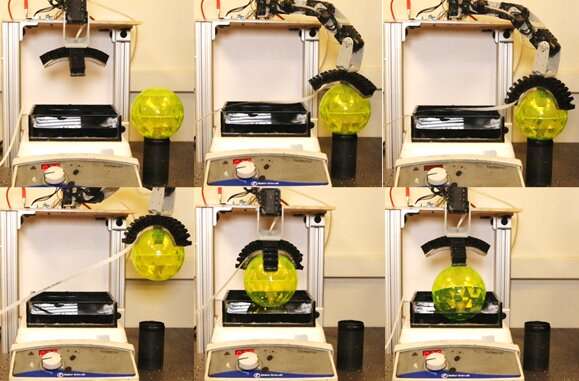
The bean plant with electronic roots (the dark roots).
Credit: Thor Balkhed
By watering bean plants (Phaseolus vulgaris) with a solution that contains conjugated oligomers, researchers at the Laboratory of Organic Electronics, have shown that the roots of the plant become electrically conducting and can store energy.
Dr Eleni Stavrinidou, associate professor and principal investigator in the Electronic Plants Group at the Laboratory of Organic Electronics, showed in 2015 that circuits can be fabricated in the vascular tissue of roses. The conducting polymer PEDOT was absorbed by the plant´s vascular system to form electrical conductors that were used to make transistors. In a later work in 2017, she demonstrated that a conjugated oligomer, ETE-S, could polymerise in the plant and form conductors that can be used to store energy.
From plants cuttings to intact plants
“We have previously worked with plants cuttings, which were able to take up and organise conducting polymers or oligomers. However, the plant cuttings can survive for only a few days, and the plant is not growing anymore. In this new study we use intact plants, a common bean plant grown from seed, and we show that the plants become electrically conducting when they are watered with a solution that contains oligomers”, says Eleni Stavrinidou.
The researchers here have used a trimer, ETE-S, which is polymerised by a natural process in the plant. A conducting film of polymer is formed on the roots of the plant, which causes the complete root system to function as a network of readily accessible conductors.
The bean plant roots remained electrically conducting for at least four weeks, with a conductivity in the roots of approximately 10 S/cm (Siemens per centimetre).
Storing energy
The researchers investigated the possibility of using the roots to store energy, and built a root-based supercapacitor in which the roots functioned as electrodes during charging and discharging.
“Supercapacitors based on conducting polymers and cellulose are an eco-friendly alternative for energy storage that is both cheap and scalable”, says Eleni Stavrinidou.
The root-based supercapacitor worked well, and could store 100 times more energy than previous experiments with supercapacitors in plants that used the plant stem. The device can also be used over extended periods of time since the bean plants in the experiments continued to live and thrive.
“The plant develops a more complex root system, but is otherwise not affected: it continues to grow and produce beans”, Eleni Stavrinidou assures us.
Highly significant results
The results, which have been published in the scientific journal Materials Horizons, are highly significant, not just for the development of sustainable energy storage, but also for the development of new biohybrid systems, such as functional materials and composites. The electronic roots are also a major contribution to the development of seamless communication between electronic and biological systems.
The research group consists of researchers from the Laboratory of Organic Electronics, the Umeå Plant Science Center, the Wallenberg Wood Science Center at Linköping University, and from universities and research institutes in France, Greece and Spain.
Original Article: Storing energy in plants with electronic roots
More from: Linköping University
The Latest Updates from Bing News & Google News
Go deeper with Bing News on:
Storing energy in plants
- DTE Energy in Detroit Requests Bids for Standalone Energy Storage Projects
DTE Energy announced company is issuing a Request for Proposal (RFP) for new standalone energy storage projects totaling 20 megawatts.
- DTE Energy seeks 120 MW of new energy storage projects
DTE Energy is issuing a Request for Proposal (RFP) for new standalone energy storage projects totaling approximately 120 MW. These projects will support DTE Electric’s CleanVision Integrated Resource ...
- Residents worry about battery storage plant moving into neighborhood
Similar to homeowners, NextEra was unaware that College Park City Council planned to vote on the rezoning of the property, during a March 18 meeting, and an accompanying payment of $1.6 million, ...
- Coal power stations in NH converting to battery storage for offshore wind | CloseUp
On CloseUp, Granite Shore Power highlighted its plan to transition the Merrimack and Schiller stations to battery storage for anticipated development of offshore wind platforms in the Gulf of Maine.
- Hydrostor to break ground on two compressed air plants
Canadian energy storage developer Hydrostor has announced its intention to build 200MW/1,600MWh compressed air energy storage(CAES) system at the border town ...
Go deeper with Google Headlines on:
Storing energy in plants
[google_news title=”” keyword=”storing energy in plants” num_posts=”5″ blurb_length=”0″ show_thumb=”left”]
Go deeper with Bing News on:
Biohybrid systems
- Biohybrid robot made from flour and oats could act as a biodegradable vector for reforestation
Researchers at Istituto Italiano di Tecnologia (IIT-Italian Institute of Technology) in collaboration with the University of Freiburg have developed a biohybrid robot, which consists of a flour-based ...
- Best Home Security Systems Of 2024
Commissions do not affect our editors' opinions or evaluations. Home security systems help keep your family and possessions safe while you’re home or away. The best home security systems provide ...
- Best DIY Home Security Systems of 2024
Macy Meyer is a N.C. native who graduated from UNC-Chapel Hill in 2021 with a B.A. in English and Journalism. She currently resides in Charlotte, N.C., where she has been working as an Editor I ...
- Best POS Systems For Small Business 2024
Commissions do not affect our editors' opinions or evaluations. The best point-of-sale (POS) systems do more than process transactions. These systems can also streamline your daily workflow by ...
- Best Home Security Systems of May 2024
Our experts have taken the time to review the best home security systems on the market, breaking them up by customer focus and benefit. Ready to learn more? We’ve done the heavy lifting for you ...
Go deeper with Google Headlines on:
Biohybrid systems
[google_news title=”” keyword=”biohybrid systems” num_posts=”5″ blurb_length=”0″ show_thumb=”left”]











